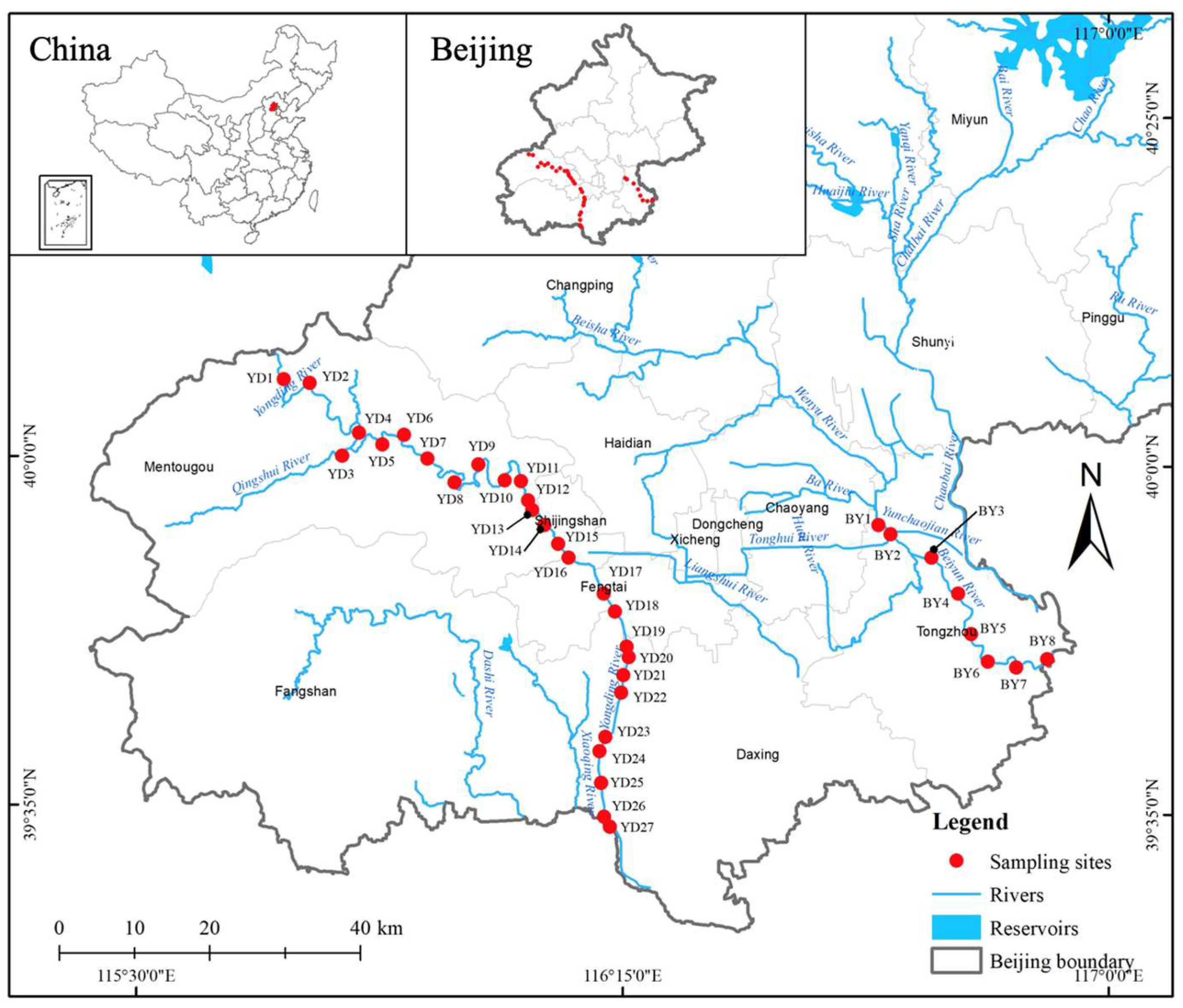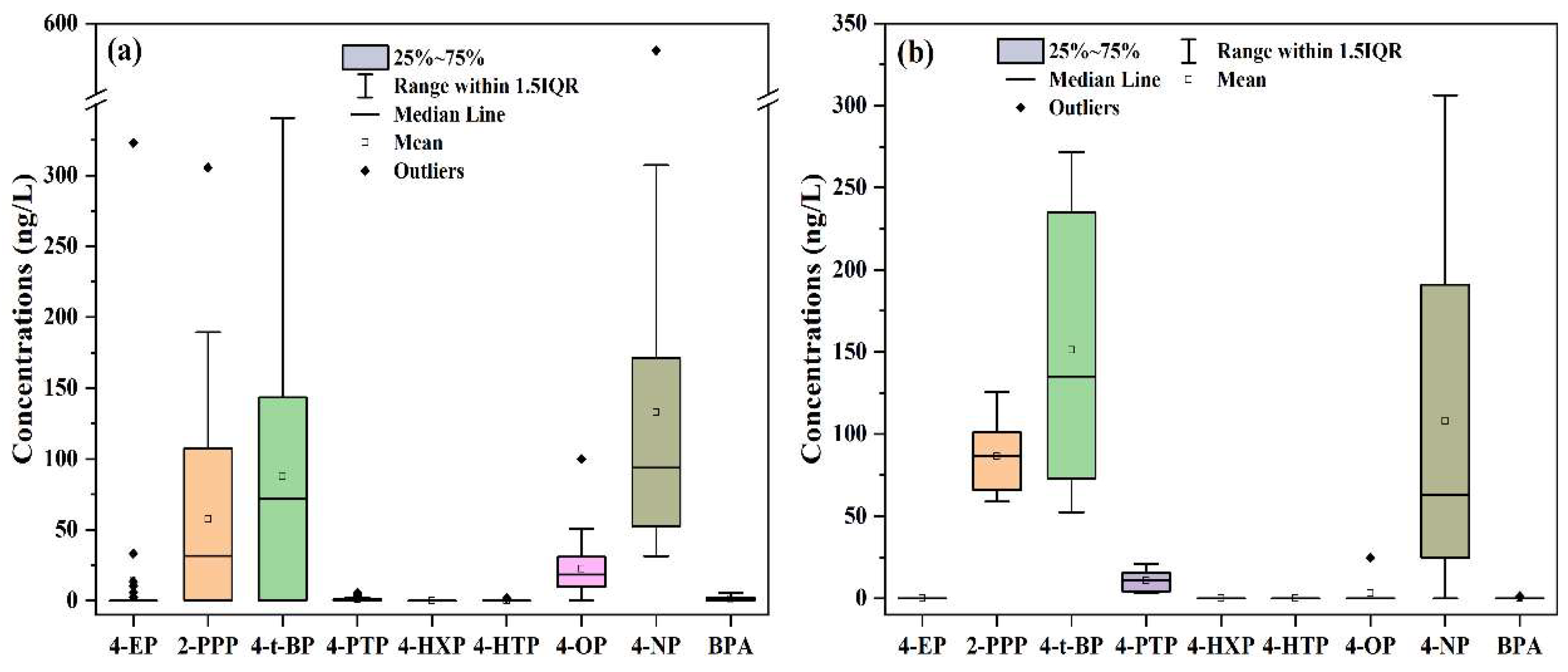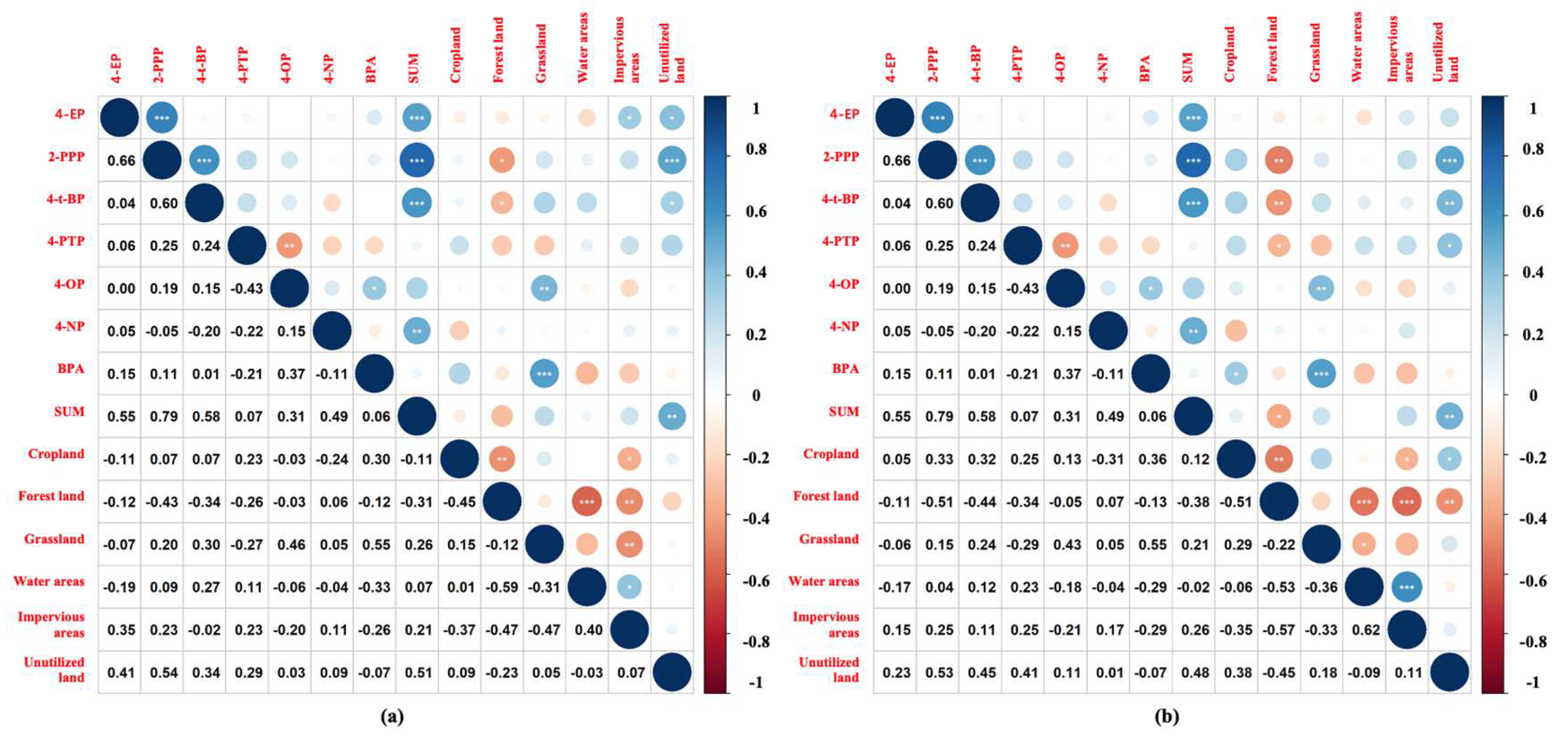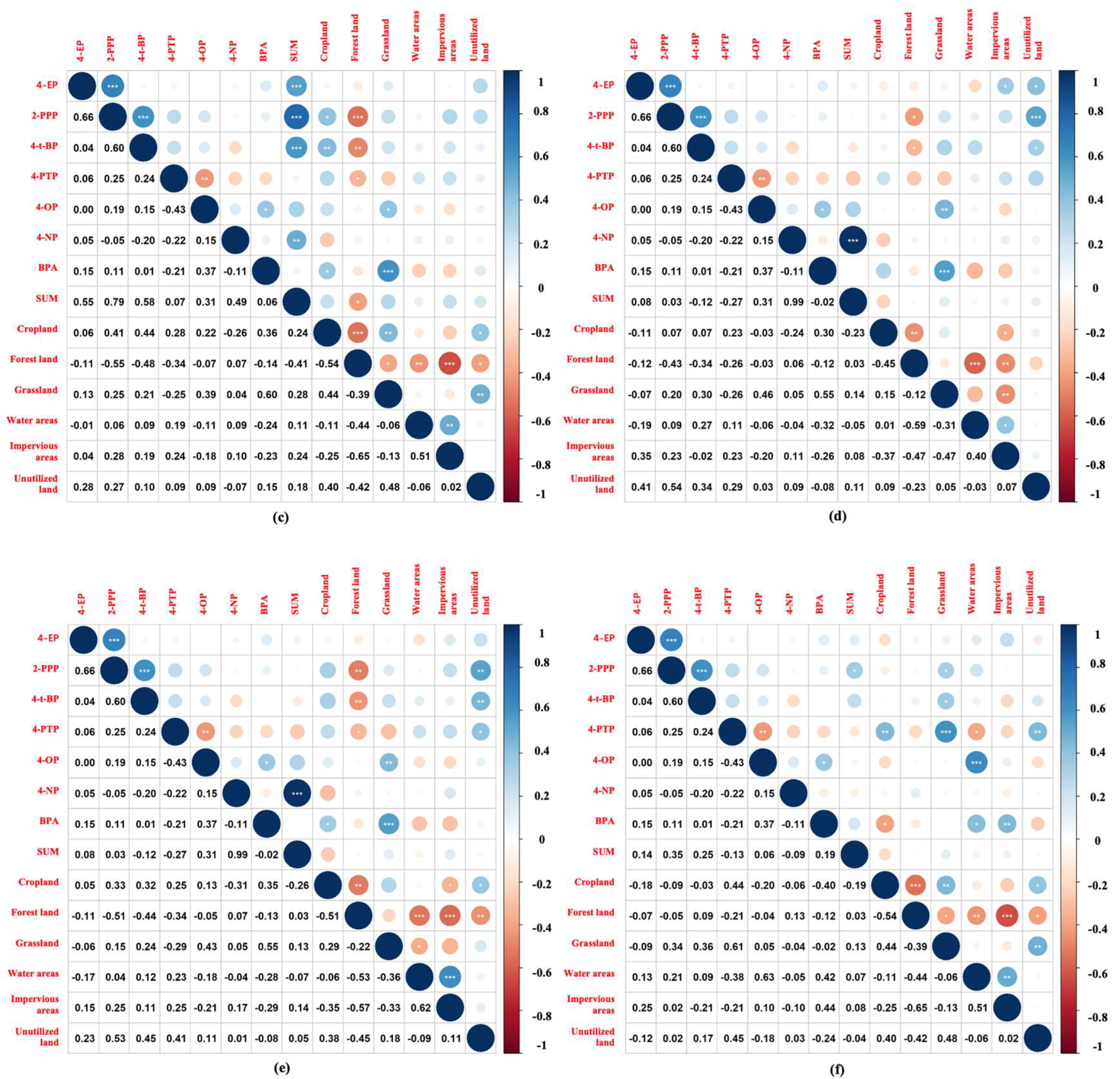The Distribution Characteristics and Ecological Risks of Alkylphenols and the Relationships between Alkylphenols and Different Types of Land Use
Abstract
:1. Introduction
2. Materials and Methods
2.1. Chemicals and Reagents
2.2. Sample Collection and Preparation
2.3. Sample Analysis
2.4. Quality Assurance and Control Measures
2.5. Principal Component and Difference Analyses
2.6. Spatial Analysis
3. Results and Discussion
3.1. Distribution Characteristics of the Concentration Levels of the APs
3.2. Spatial Distribution of the Concentrations of APs
3.3. Spatial Distribution Differences in the APs
3.4. Relationships between the Types of Land Use and the Concentrations and Risk Quotient of the APs
4. Conclusions
Supplementary Materials
Author Contributions
Funding
Institutional Review Board Statement
Informed Consent Statement
Data Availability Statement
Conflicts of Interest
References
- Vörösmarty, C.J.; McIntyre, P.B.; Gessner, M.O.; Dudgeon, D.; Prusevich, A.; Green, P.; Glidden, S.; Bunn, S.E.; Sullivan, C.A.; Reidy Liermann, C.; et al. Global threats to human water security and river biodiversity. Nature 2010, 467, 555. [Google Scholar] [CrossRef] [PubMed] [Green Version]
- Li, X.; Yeh, A.G.-O. Analyzing spatial restructuring of land use patterns in a fast growing region using remote sensing and GIS. Landsc. Urban Plan. 2004, 69, 335–354. [Google Scholar] [CrossRef]
- Costanza, R.; D’arge, R.; De Groot, R.; Farber, S. The value of the world’s ecosystem services and natural capital. Ecol. Econ. 1998, 25, 3–15. [Google Scholar] [CrossRef]
- Xu, G.Y.; Wng, Z.J.; Hu, Z.D.; Habets, F. Comprehensive index evaluation of land use and cover in Qaidam Basin. J. Hydroelectr. 2019, 38, 44–55. [Google Scholar]
- Lei, K.; Zhu, Y.; Chen, W.; Pan, H.Y.; Cao, Y.X.; Zhang, X.; Guo, B.B.; Sweetman, A.; Lin, C.Y.; Ouyang, W.; et al. Spatial and seasonal variations of antibiotics in river waters in the Haihe River Catchment in China and ecotoxicological risk assessment. Environ. Int. 2019, 130, 104919. [Google Scholar] [CrossRef]
- Zhang, S.; Zheng, Y.T.; Zhan, A.B.; Dong, C.X.; Zhao, J.D.; Yao, M. Environmental DNA captures native and non-native fish community variations across the lentic and lotic systems of a megacity. Sci. Adv. 2022, 8, eabk0097. [Google Scholar] [CrossRef]
- Dai, D.; Sun, M.D.; Lv, X.B.; Lei, K. Evaluating water resource sustainability from the perspective of water resource carrying capacity, a case study of the Yongding River watershed in Beijing-Tianjin-Hebei region, China. Environ. Sci. Pollut. Res. 2020, 27, 21590–21603. [Google Scholar] [CrossRef]
- Jiang, B.; Wong, C.P.; Lu, F.; Ouyang, Z.Y.; Wang, Y.J. Drivers of drying on the Yongding River in Beijing. J. Hydrol. 2014, 519, 69–79. [Google Scholar] [CrossRef]
- Meng, J.; Zhou, Y.Q.; Liu, S.F.; Chen, S.Q.; Wang, T.Y. Increasing perfluoroalkyl substances and ecological process from the Yongding Watershed to the Guanting Reservoir in the Olympic host cities, China. Environ. Int. 2019, 133, 105224. [Google Scholar] [CrossRef]
- Guo, W.; Fu, Y.; Ruan, B.; Ge, H.; Zhao, N. Agricultural non-point source pollution in the Yongding River Basin. Ecol. Indic. 2014, 36, 254–261. [Google Scholar] [CrossRef]
- Guo, Z.; Su, Z.; Di, Y.; Guo, X. Analysis on Diversity of Plankton Microbial Community in the Beijing-Tianjin-Hebei Section of the North Canal River. Environ. Sci. 2022, 43, 803–812. [Google Scholar]
- Esteban, S.; Gorga, M.; Petrovic, M.; Gonzalez-Alonso, S.; Barcelo, D.; Valcarcel, Y. Analysis and occurrence of endocrine-disrupting compounds and estrogenic activity in the surface waters of Central Spain. Sci. Total Environ. 2014, 466–467, 939–951. [Google Scholar] [CrossRef]
- Klosterhaus, S.L.; Grace, R.; Hamilton, M.C.; Yee, D. Method validation and reconnaissance of pharmaceuticals, personal care products, and alkylphenols in surface waters, sediments, and mussels in an urban estuary. Environ. Int. 2013, 54, 92–99. [Google Scholar] [CrossRef]
- Liao, C.Y.; Kannan, K. A survey of alkylphenols, bisphenols, and triclosan in personal care products from China and the United States. Arch. Environ. Contam. Toxicol. 2014, 67, 50–59. [Google Scholar] [CrossRef]
- Bergé, A.; Cladière, M.; Gasperi, J.; Coursimault, A.; Tassin, B.; Moilleron, R. Meta-analysis of environmental contamination by alkylphenols. Environ. Sci. Pollut. Res. 2012, 19, 3798–3819. [Google Scholar] [CrossRef]
- Bergé, A.; Gasperi, J.; Rocher, V.; Gras, L.; Coursimault, A.; Moilleron, R. Phthalates and alkylphenols in industrial and domestic effluents: Case of Paris conurbation (France). Sci. Total Environ. 2014, 488–489, 26–35. [Google Scholar] [CrossRef] [Green Version]
- Urbatzka, R.; Rocha, E.; Reis, B.; Cruzeiro, C.; Monteiro, R.A.F.; Rocha, M.J. Effects of ethinylestradiol and of an environmentally relevant mixture of xenoestrogens on steroidogenic gene expression and specific transcription factors in zebrafish. Environ. Pollut. 2012, 164, 28–35. [Google Scholar] [CrossRef]
- Wang, B.; Dong, F.Q.; Chen, S.; Chen, M.J.; Bai, Y.C.; Tan, J.Y.; Li, F.C.; Wang, Q. Phenolic endocrine disrupting chemicals in an urban receiving river (Panlong river) of Yunnan-Guizhou plateau: Occurrence, bioaccumulation and sources. Ecotoxicol. Environ. Saf. 2016, 128, 133–142. [Google Scholar] [CrossRef]
- Lei, K.; Pan, H.Y.; Zhu, Y.; Chen, W.; Lin, C.Y. Pollution characteristics and mixture risk prediction of phenolic environmental estrogens in rivers of the Beijing-Tianjin-Hebei urban agglomeration, China. Sci. Total Environ. 2021, 787, 147646. [Google Scholar] [CrossRef]
- Cheng, J.R.; Wang, K.; Yu, J.; Yu, Z.X.; Yu, X.B.; Zhang, Z.Z. Distribution and fate modeling of 4-nonylphenol, 4-t-octylphenol, and bisphenol A in the Yong River of China. Chemosphere 2018, 195, 594–605. [Google Scholar] [CrossRef]
- Li, Z.H.; Zhang, W.Q.; Shan, B.Q. The effects of urbanization and rainfall on the distribution of, and risks from, phenolic environmental estrogens in river sediment. Environ. Pollut. 2019, 250, 1010–1018. [Google Scholar] [CrossRef] [PubMed]
- Hong, Y.J.; Feng, C.L.; Yan, Z.F.; Wang, Y.; Liu, D.Q.; Liao, W.; Bai, Y.C. Nonylphenol occurrence, distribution, toxicity and analytical methods in freshwater. Environ. Chem. Lett. 2020, 18, 2095–2106. [Google Scholar] [CrossRef]
- Qiu, W.H.; Liu, S.; Chen, H.H.; Luo, S.S.; Xiong, Y.; Wang, X.J.; Xu, B.T.; Zheng, C.M.; Wang, K.J. The comparative toxicities of BPA, BPB, BPS, BPF, and BPAF on the reproductive neuroendocrine system of zebrafish embryos and its mechanisms. J. Hazard. Mater. 2021, 406, 124303. [Google Scholar] [CrossRef] [PubMed]
- Jiang, J.; Zhao, G.; Xu, Y.; Zhao, J.; Liu, L.; Liu, C.; Wang, D.; Li, Y. Occurrence and distribution characteristics of heavy metals in the surface water of Yongding River Basin, China. Environ. Sci. Pollut. Res. Int. 2021, 29, 17821–17831. [Google Scholar] [CrossRef]
- Gu, Y.Y.; Yu, J.; Hu, X.L.; Yin, D.Q. Characteristics of the alkylphenol and bisphenol A distributions in marine organisms and implications for human health: A case study of the East China Sea. Sci. Total Environ. 2016, 539, 460–469. [Google Scholar] [CrossRef] [PubMed]
- Hong, Y.J.; Feng, C.L.; Jin, X.W.; Xie, H.Y.; Liu, N.; Bai, Y.C.; Wu, F.C.; Raimondo, S. A QSAR-ICE-SSD model prediction of the PNECs for alkylphenol substances and application in ecological risk assessment for rivers of a megacity. Environ. Int. 2022, 167, 107367. [Google Scholar] [CrossRef]
- Li, P.; Zhang, W.; Lu, C.; Zhang, R.; Li, X. Robust kernel principal component analysis with optimal mean. Neural Netw. 2022, 152, 347–352. [Google Scholar] [CrossRef]
- Li, F.L.; Altermatt, F.; Yang, J.H.; An, S.Q.; Li, A.M.; Zhang, X.W. Human activities’ fingerprint on multitrophic biodiversity and ecosystem functions across a major river catchment in China. Glob. Change Biol. 2020, 26, 6867–6879. [Google Scholar] [CrossRef]
- Seymour, M.; Deiner, K.; Altermatt, F. Scale and scope matter when explaining varying patterns of community diversity in riverine metacommunities. Basic Appl. Ecol. 2016, 17, 134–144. [Google Scholar] [CrossRef] [Green Version]
- Noorimotlagh, Z.; Kazeminezhad, I.; Jaafarzadeh, N.; Ahmadi, M.; Ramezani, Z.; Silva Martinez, S. The visible-light photodegradation of nonylphenol in the presence of carbon-doped TiO2 with rutile/anatase ratio coated on GAC: Effect of parameters and degradation mechanism. J. Hazard. Mater. 2018, 350, 108–120. [Google Scholar] [CrossRef]
- Zhi, X.; Chen, L.; Shen, Z. Impacts of urbanization on regional nonpoint source pollution: Case study for Beijing, China. Environ. Sci. Pollut. Res. 2018, 25, 9849–9860. [Google Scholar] [CrossRef]
- Jing, H.; Zhang, Z.; Guo, J. Water pollution characteristics and pollution sources of Bei Canal river system in Beijing. China Environ. Sci. 2013, 33, 319–327. [Google Scholar]
- Soares, A.; Guieysse, B.; Jefferson, B.; Cartmell, E.; Lester, J.N. Nonylphenol in the environment: A critical review on occurrence, fate, toxicity and treatment in wastewaters. Environ. Int. 2008, 34, 1033–1049. [Google Scholar] [CrossRef]
- Yu, M.; Cai, Y.; Liu, H.; Gong, L.; Leng, X.; An, S. Impact of Land Use on Water Quality Along Inflow Rivers in Taihu Basin. J. Agro-Environ. Sci. 2014, 33, 1024–1032. [Google Scholar]
- Liu, S.; Wang, C.; Wang, P.F.; Chen, J.; Wang, X.; Yuan, Q.S. Anthropogenic disturbances on distribution and sources of pharmaceuticals and personal care products throughout the Jinsha River Basin, China. Environ. Res. 2021, 198, 110449. [Google Scholar] [CrossRef]
- Xie, H.J.; Chen, J.W.; Huang, Y.; Zhang, R.H.; Chen, C.E.; Li, X.H.; Kadokami, K. Screening of 484 trace organic contaminants in coastal waters around the Liaodong Peninsula, China: Occurrence, distribution, and ecological risk. Environ. Pollut. 2020, 267, 115436. [Google Scholar] [CrossRef]
- Xiong, T.; Qian, Y.; Wei, S.; Geng, J.; Yu, Q.; Ren, H. High-throughput screening and source analysis of emerging contaminants in surface water of Wujin River Basin. Acta Sci. Circumstantiae 2022, 42, 260–270. [Google Scholar]
- Giri, S.; Qiu, Z. Understanding the relationship of land uses and water quality in Twenty First Century: A review. J. Environ. Manag. 2016, 173, 41–48. [Google Scholar] [CrossRef] [Green Version]
- Zhang, M.; Shi, Y.J.; Lu, Y.L.; Johnson, A.C.; Sarvajayakesavalu, S.; Liu, Z.Y.; Su, C.; Zhang, Y.Q.; Juergens, M.D.; Jin, X.W. The relative risk and its distribution of endocrine disrupting chemicals, pharmaceuticals and personal care products to freshwater organisms in the Bohai Rim, China. Sci. Total Environ. 2017, 590–591, 633–642. [Google Scholar] [CrossRef] [Green Version]
- Hong, B.; Lin, Q.Y.; Yu, S.; Chen, Y.S.; Chen, Y.M.; Chiang, P.C. Urbanization gradient of selected pharmaceuticals in surface water at a watershed scale. Sci. Total Environ. 2018, 634, 448–458. [Google Scholar] [CrossRef]
- Ferreira, P.; van Soesbergen, A.; Mulligan, M.; Freitas, M.; Vale, M.M. Can forests buffer negative impacts of land-use and climate changes on water ecosystem services? The case of a Brazilian megalopolis. Sci. Total Environ. 2019, 685, 248–258. [Google Scholar] [CrossRef] [PubMed]
- Sliva, L.; Williams, D.D. Buffer zone versus whole catchment approaches to studying land use impact on river water quality. Water Res. 2001, 35, 3462–3472. [Google Scholar] [CrossRef] [PubMed]
- Paerl, H.W.; Paul, V.J. Climate change: Links to global expansion of harmful cyanobacteria. Water Res. 2012, 46, 1349–1363. [Google Scholar] [CrossRef] [PubMed]
- Allan, J.D.; Erickson, D.L.; Fay, J. The influence of catchment land use on stream integrity across multiple spatial scales. Freshw. Biol. 1997, 37, 149–161. [Google Scholar] [CrossRef] [Green Version]
- Thomson, J.R.; Bond, N.R.; Cunningham, S.C.; Metzeling, L.; Reich, P.; Thompson, R.M.; Nally, R.M. The influences of climatic variation and vegetation on stream biota: Lessons from the Big Dry in southeastern Australia. Glob. Change Biol. 2012, 18, 1582–1596. [Google Scholar] [CrossRef]







| APs | Yongding River | Beiyun River | ||||||||
|---|---|---|---|---|---|---|---|---|---|---|
| MAX | MIN | MED | AVE | Detected No. | MAX | MIN | MED | AVE | Detected No. | |
| 4-EP | 322.9 | ND | ND | 14.4 | 6 | ND | ND | ND | ND | 0 |
| 2-PPP | 305.4 | ND | 31.6 | 57.6 | 19 | 125.5 | 59.0 | 86.7 | 86.5 | 8 |
| 4-t-BP | 340.6 | ND | 71.7 | 88.0 | 19 | 271.6 | 52.4 | 135.2 | 151.2 | 8 |
| 4-PTP | 5.6 | ND | ND | 0.8 | 9 | 21.1 | 3.2 | 11.2 | 10.8 | 8 |
| 4-HXP | ND | ND | ND | ND | 0 | ND | ND | ND | ND | 0 |
| 4-HTP | 1.7 | ND | ND | 0.1 | 1 | ND | ND | ND | ND | 0 |
| 4-OP | 99.9 | ND | 18.4 | 22.5 | 24 | 24.8 | ND | ND | 3.1 | 1 |
| 4-NP | 580.8 | 31.4 | 93.7 | 133.0 | 27 | 306.3 | ND | 63.1 | 108.0 | 7 |
| BPA | 5.3 | ND | ND | 1.2 | 11 | 1.3 | ND | ND | 0.2 | 1 |
Disclaimer/Publisher’s Note: The statements, opinions and data contained in all publications are solely those of the individual author(s) and contributor(s) and not of MDPI and/or the editor(s). MDPI and/or the editor(s) disclaim responsibility for any injury to people or property resulting from any ideas, methods, instructions or products referred to in the content. |
© 2023 by the authors. Licensee MDPI, Basel, Switzerland. This article is an open access article distributed under the terms and conditions of the Creative Commons Attribution (CC BY) license (https://creativecommons.org/licenses/by/4.0/).
Share and Cite
Hong, Y.; Chen, M.; Zhu, Z.; Liao, W.; Feng, C.; Yan, Z.; Qiao, Y.; Mei, Y.; Xu, D. The Distribution Characteristics and Ecological Risks of Alkylphenols and the Relationships between Alkylphenols and Different Types of Land Use. Toxics 2023, 11, 579. https://doi.org/10.3390/toxics11070579
Hong Y, Chen M, Zhu Z, Liao W, Feng C, Yan Z, Qiao Y, Mei Y, Xu D. The Distribution Characteristics and Ecological Risks of Alkylphenols and the Relationships between Alkylphenols and Different Types of Land Use. Toxics. 2023; 11(7):579. https://doi.org/10.3390/toxics11070579
Chicago/Turabian StyleHong, Yajun, Miao Chen, Ziwei Zhu, Wei Liao, Chenglian Feng, Zhenfei Yan, Yu Qiao, Yaru Mei, and Dayong Xu. 2023. "The Distribution Characteristics and Ecological Risks of Alkylphenols and the Relationships between Alkylphenols and Different Types of Land Use" Toxics 11, no. 7: 579. https://doi.org/10.3390/toxics11070579
APA StyleHong, Y., Chen, M., Zhu, Z., Liao, W., Feng, C., Yan, Z., Qiao, Y., Mei, Y., & Xu, D. (2023). The Distribution Characteristics and Ecological Risks of Alkylphenols and the Relationships between Alkylphenols and Different Types of Land Use. Toxics, 11(7), 579. https://doi.org/10.3390/toxics11070579







